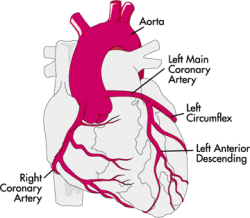|
Radiation
Limits Common Heart Bypass Complication
A recent study has
found that a jolt of radiation can help keep the blood vessels of the
heart from getting clogged up with scar tissue after coronary bypass surgery.
While the approach
is still in an experimental stage, it could help solve a problem that
effects many of the one million Americans who get bypass surgery or angioplasty
every year.
 When
performing bypass surgery, doctors frequently use a vein taken from the
leg to reroute blood around clogged arteries. But these grafts are prone
to becoming clogged as well. Approximately 40 percent fill up within 10
years. When
performing bypass surgery, doctors frequently use a vein taken from the
leg to reroute blood around clogged arteries. But these grafts are prone
to becoming clogged as well. Approximately 40 percent fill up within 10
years.
To combat this, doctors often perform angioplasty on the graft, squeezing
it open with a tiny balloon and then inserting a metal mesh tube, called
a stent, to keep it open. But muscle cells inside the graft sometimes
form scars tissue that grows over the sateen, limiting blood flow.
Researchers at Washington Hospital Center tested radiation on 120 bypass
patients who had clogged stents. The results are reported in the New England
Journal of Medicine.
What researchers found was that those patients who received the radiation
were only half as likely as other patients to have a heart attack or experience
new re-narrowing of their grafts, or even die during the following year.
Many times, a repeat bypass operation is necessary on patients whose stents
become clogged again.
This can be risky.
The study's director, Dr. Ron Waksman, said that "We really want
to see if we can salvage those veins grafts so we can prevent a second
bypass surgery."
The Food and Drug Administration has approved two systems for delivering
radiation to the heart. The latest study involved the Cordis system which
is manufactured by Johnson & Johnson.
Clogging is also a major problem after angioplasty is done on the heart's
own arteries rather than the graft. Doctors hope that most of this problem
can be eliminated by the invention of a new drug coated from of stent
that appears to inhibit clogging.
At least eight varieties of these experimental stents, coated with different
medicines are now being tested. The results are showing promise on a relatively
small number of patients.
According to Dr.
Richard O. Cannon III of the National Heart, Lung and Blood Institute,
clogging is likely to remain a problem, at least for a while and solutions
like radiation will be needed.
The the most recent study, half of the patients were selected randomly
for radiation, and a tiny ribbon containing radioactive seeds was threaded
through the graft and inside the stent, then left there for 20 minutes.
In another group of patients, a ribbon holding an inactive substance was
used, without anyone knowing who got what.
Six months later, clogging had occurred in 21 percent of the radiation
patients, compared with 44 percent of those patients getting the dummy
treatments.
|

